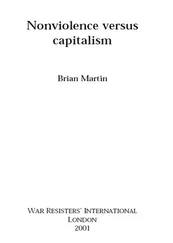Nevertheless, the campaign was a success because of a different process of conversion. Observing the operation was a journalist for the United Press in the US, Webb Miller. His moving reports reached an enormous international audience, challenging the disinformation of the official reports. Public opinion in many countries was turned against the British role in India. It was this conversion process that helped achieve India’s independence.
Johan Galtung’s idea of a “great chain of nonviolence” is quite relevant in this connection, [34] . Johan Galtung, Nonviolence and Israel/Palestine (Honolulu: University of Hawaii Institute for Peace, 1989).
as noted by Weber. Galtung argues that nonviolence can work to persuade opponents via intermediaries: a chain of people, each similar enough in social location, who communicate the social concerns. In the case of the salt satyagraha, Webb Miller provided a link between the satyagrahis and white westerners; in turn, some of the latter had links with British colonial decision-makers.
An interesting connection can be made between Gandhi’s idea of satyagraha and Jürgen Habermas’s theory of communicative action, in particular his “ideal speech situation.” [35] . Jürgen Habermas, The Theory of Communicative Action, Vol. 1. Reason and the Rationalization of Society (Boston: Beacon Press, 1984); Jürgen Habermas, The Theory of Communicative Action, Vol. 2. Lifeworld and System: A Critique of Functionalist Reason (Boston: Beacon Press, 1987).
Habermas’s ideal speech situation builds on the capacity of all humans to communicate, to enter dialogue and reach intersubjective agreement (rather than individually find truth in nature). In other words, truth for Habermas is obtained through rational discussion in the absence of domination. This theory, though, provides little guidance for communication in situations of unequal power. The confrontation between the satyagrahis and the police at Dharasana in 1930 was very far from an ideal speech situation.
However, the relationship between the satyagrahis and Webb Miller was closer to an ideal speech situation: neither had significant power over the other. The cultural gap between Miller and his western readers was far less than between the satyagrahis and the British colonial rulers. So it might be said that Galtung’s great chain of nonviolence operates in practice like a chain of “reasonable speech situations” which, while certainly not ideal, provide better prospects for the sharing and creating of truths than the two end points of the chain.
Thus, Gandhi’s idea that the willing suffering of nonviolent activists can communicate direct to the hearts of oppressors requires considerable modification. Communication of truth works better when there is no power imbalance, and this means that communication via intermediaries is often more effective than direct communication between unequals.
Assessment of Communication Technologies
These considerations suggest that communication technologies that foster or enable dialogue are more useful for the purposes of nonviolent action than those that inhibit dialogue. If one side in a dispute controls television and radio stations, there is no dialogue. Even if a substantial proportion of the population refuses to listen, the communication imbalance continues. There is little or no opportunity for listeners to present their points of view. It is not surprising, therefore, that dictatorships normally exercise complete control over one-directional electronic communication media. The value of radio and television to oppressors is highlighted by the fact that they are often the first targets in military coups.
The same considerations apply to communication among those who resist an oppressor. With a one-directional means of communication, resistance leaders can certainly get their messages to supporters with minimum effort — but these leaders become quite vulnerable to both repression and cooption. Even more importantly, without dialogue, the resistance cannot take into account the views of current and possible supporters, and cannot foster the capacities of others to use skills and take initiatives.
If the only means of communication in a society were interactive, network systems — face-to-face discussion, telephone, short-wave and CB radio, and computer networks — then an aggressor or oppressor would have the greatest difficulty in controlling the population. Network communication technologies do not by themselves eliminate hierarchy and exploitation, but they do aid resistance. The telephone can be used to issue orders, but it is far too labour-intensive for controlling large populations. Also, the subordinate can always talk back.
James C. Scott’s idea of public and hidden transcripts is relevant here. [36] . James C. Scott, Domination and the Arts of Resistance: Hidden Transcripts (New Haven, CT: Yale University Press, 1990).
In situations of domination, such as slavery, aristocrat-peasant relations and landlord-tenant relations, the public record or transcript tells the story of the dominators. There is also a hidden transcript in which the side of the oppressed is revealed. According to Scott, the oppressed are well aware of their oppression: the concept of false consciousness is false. The hidden transcript can be a rehearsal for a challenge to powerholders, a challenge that can develop quickly when the mechanisms holding back resistance are weakened.
In the modern world, mass media are a form of public transcript. The mass media under dictatorships omit the perspective of the oppressed, who therefore must use other media — covert discussions, graffiti, leaflets and clandestine radio, as well as symbolic communication at funerals, concerts and other “legitimate” events — to share experiences. This also applies to some aspects of life in societies with representative government: for example, police treatment of stigmatised minorities, or oppression and alienation in working life, are seldom portrayed in the mass media. Thus, mass media are useful tools for dominators, whereas network media are useful for developing the voices of the weak.
Galtung’s “great chain of nonviolence” provides another way to explain the advantage of network media for nonviolent resistance. With mass media, the chance of a chain of reasonable speech situations between the oppressed and the oppressors is limited. With network media, the chance is increased, and the denser the interlinkings of the communication network, the greater the ease of dialogical communication.
Several of the examples given in this chapter support the conclusion that mass media are selectively useful for oppressors. For example, control over the mass media was crucial to government and military control in the shutting down and censoring of the press during the Emergency in India, in the cutting off of electronic communication during the military coup in Poland and throughout the continuing occupation of East Timor. Similarly, control over the mass media was a crucial factor in the Fiji coups and in the Shah’s Iran. But in these two cases the opposition had access to alternative sources of information, via short-wave radio in Fiji and cassette tapes in Iran.
On the other hand, some of the cases seem to contradict the idea that mass media are selectively useful for oppressors. Radio broadcasts were vital to nonviolent resistance in the Algerian generals’ revolt, the Czechoslovak resistance to the Warsaw Pact invasion, and the collapse of the East German communist regime. In each of these cases, a one-directional medium served a nonviolent resistance to repression. What made this possible was a short-term congruence between those who controlled the medium and a dialogue-based mass movement. French conscripts in Algeria, through their own experiences and interactions, were already predisposed to refuse cooperation. De Gaulle’s broadcast made them aware that they were supported by the French government and the French people.
Читать дальше












